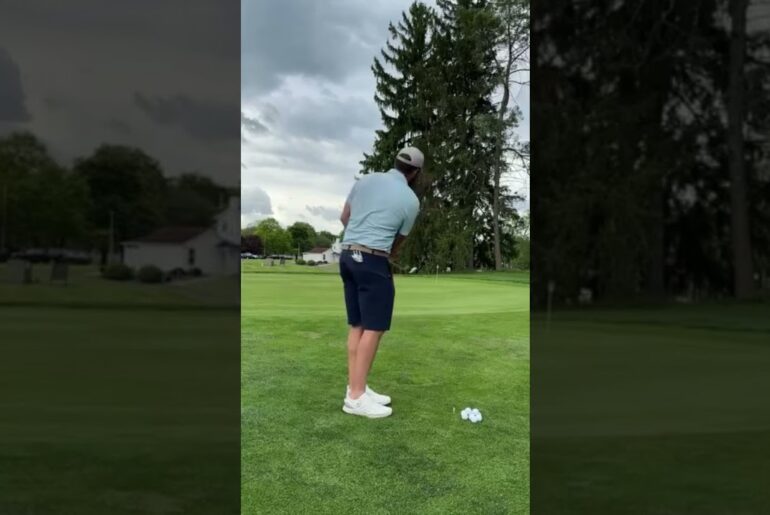Learn the secret golf trail leg technique from Happy Gilmore swing that creates perfect golf weight shift and improves ball striking instantly!
Watch more ‘Tour Quality Ball Striking’ HERE – https://rob-cheney.mykajabi.com/joinus
📲 Online Lessons via SKILLEST app – https://skillest.com/robcheneygolf
📅 Upcoming Events – https://www.robcheneygolf.com/events
Become a member – https://www.youtube.com/channel/UC14EwLYUwQ_hZJG09z8O2kw/join
iRangeSports – https://irangesports.com/?ref=sqkrivhf CODE = ‘ROBCHENEYGOLF’ for 10% off
0:00 🏌️ Happy Gilmore swing lesson introduction – what great ball strikers do
0:33 ⚡ Trail leg as breaking mechanism for power transfer
1:16 💪 Two key benefits: breaking mechanism and weight transfer
2:45 🎯 How slowing hips speeds up the golf club
3:09 📍 Golf weight shift – keeping trail leg straight for forward hip movement
4:46 🔧 Simple drill: pull trail foot back at setup
5:55 🛹 Advanced drill: actively slide foot back during swing
7:31 🚧 Constraint drill using barriers to train proper trail leg movement
9:45 ✅ Final swing demonstration without touching the constraint
This comprehensive golf instruction video reveals the biomechanical secret behind Happy Gilmore’s powerful swing that’s also used by tour professionals like Scotty Scheffler and Rory McIlroy. You’ll discover how proper golf trail leg movement creates a breaking mechanism that transfers maximum power to the ball while ensuring consistent golf weight shift forward for better contact.
What you’ll learn:
-The breaking mechanism concept – how slowing your hips actually speeds up your golf club
-Why keeping your trail leg straight improves forward weight transfer
-Simple setup adjustment: pulling your trail foot back for immediate improvement
-Advanced sliding drill to actively train the trail leg movement during your swing
-Constraint training using barriers to perfect the motion without bad habits
-How this technique prevents common faults like hitting behind the ball and slicing
-The connection between Happy Gilmore swing mechanics and modern tour players
-Why this movement is crucial for consistent ball striking across all clubs
#golftrailleg #happygilmoreswing #golfweightshift #happygilmore2
🌎 ***Check out my website www.robcheneygolf.com ***
https://www.instagram.com/robcheneygolf/
If you enjoyed the video, please LIKE 👍 and SUBSCRIBE for more golf related content ⛳️
What could you possibly learn from the swing of Happy Gilmore that would immediately improve your ball striking? And no, I’m not referring to ridiculous attempts like this to swing as fast as you possibly can. What I’m referring to is something that Happy does in his swing that is consistently demonstrated throughout history by great ball strikers. Identifying this part of the swing and incorporating this type of practice into your swing will not only improve your ball striking, but also your potential to hit the ball further as well. The movement I’m referring to is that of the trail leg in the down swing and the follow-rough. How great players use that trail leg as a breaking mechanism and also to help them move their weight far enough forward in the swing to ensure consistent contact. Happy may well have learned this during his hockey days because that movement of the trail leg is very consistent with what you would see out on the ice when someone’s hitting a slapshot. The trail leg is going back behind them. And of course, there’s a perfect example of this demonstrated by the current world number one men’s player, Scotty Sheffller, whose trail leg motion is as extreme as anybody’s. So, how can this movement in Happy Gilmore swing and Scotty Sheffller’s swing and Rory Mroy swing help you improve your golf? So, I referenced two things there that this movement helps a golfer to do. Number one, it’s a breaking mechanism which helps to transfer more power out to the club and ultimately out to the ball. And number two, it’s a way of helping a golfer to move their weight sufficiently forward, which we know is consistent among all great ball strikers across all clubs. Let’s start with that breaking mechanism concept. So, as we set up to the golf ball, we need to give some consideration to how I’m moving my lower body here. And what a lot of golfers do incorrectly is as they swing through, they turn the lower body and the upper body at the same rate. that removes the potential for transferring maximum power out from the body to the club and ultimately to the ball. If I turn all of my segments, my body, my arms, and my club at the same speed, it’s going to be very difficult to swing with any power, any great speed, it’s going to be one of the slowest ways to swing. If I swing back, swing through, swing back, swing through, I can’t really generate very much power or momentum with this golf club. And yet I see a lot of golfers falling into that trap, particularly those older golfers who’ve maybe lost a few yards in recent years, not able to fully understand that slowing down the hips can actually speed up the golf club. And that’s really what that leg movement that Happy Gilmore’s demonstrating as well as some of the best players in the world is demonstrating is a slowing down of the hip via a pulling back or a breaking bracing and breaking of the leg. So that’s the very first thing to understand that the slowing down of the hips is beneficial in terms of transferring the energy then to the arms out to the club and to the ball. If I slow my hips down and break this lower body, I can actually get more energy and more momentum out to the club. So that’s the first reason you should really be trying to apply this to your swing. The second reason it’s beneficial, I mentioned, is it helps a golfer to move their weight more forward. Why is that? Well, the longer I keep this trail leg, the straighter I make it, the longer, the greater the distance between the ankle and the hip. That means I can keep sliding my hips forward the longest. If I keep my leg and this limb as long as possible, I can keep moving my hips forward. A specific trait of great ball strikers is the amount they move their hips and their pelvis towards the target. Once again, Scotty Sheffler is a wonderful example of a golfer who moves their pelvis the most forward throughout the entire time and space of the swing. You look at how far forward his pelvis is at the end of his golf swing from where it started. And a mechanism that allows him to do that is that motion with the trail leg. So, you should really be trying to keep that leg as straight as you can to allow you to keep moving the hips forward for as long as possible. Contrary to that would be flexing this knee and effectively shortening the distance between the ankle and the right hip. Notice when I do that, the more I flex my knee, the more my pelvis has to start working backwards. Again, a move consistent with high handicap golfers, people who swing across the ball, people who hit the ground before the ball, and people who slice the ball. So, there’s a very direct correlation here between the movement of this trail leg and how good of a golfer you can be. keep it straighter for longer, straighter shots or flex it if you want to be a high handicapper struggling to play consistently. So, there’s the reasons you’d want to do it and examples of great golfers who demonstrate it. Now, the bit you’re looking for, how to do it. You can start out very, very simply just by pulling your trail foot back at setup. That would be a good start point. Keep the foot back just in the beginning. And try to feel like you keep that trail leg straighter throughout the entirety of the swing. That in and of itself can be enough to elicit the movements we’re looking for in the swing. So, I’m going to go ahead and hit this driver. I’ve got my trail foot pulled back. I’m going to try and keep my right leg as straight as possible in the down swing. Felt pretty good. I hit it a little bit high on the club face, but there’s a nice push draw. Pretty solid driver. Not too bad at all. That was just me trying to feel like I kept my trail leg straight. As I say, for many of you, that’ll be enough of an adjustment. This is also a great way to encourage bigger turn on the back swing by having the trail foot pulled back. And it also can encourage a slightly more shallow approach to the ball. All of these things are usually very beneficial for the majority of golfers out there. If you find you need to take this drill to another level, maybe just pulling the foot back doesn’t result in what you’re looking for and you notice that this trail leg is still kicking in, then you can actively try to slide the foot back as you swing. I’d encourage you to practice this first a couple of times. It can take a little bit of getting used to and some coordination, but as you swing the arms through, you’re actively trying to pull the foot back almost like you were pulling yourself along on a skateboard. Again, don’t expect miracle results immediately with this feel. But this drill will lead to sensations that you can transfer into your full swing. The braking mechanism of this trail leg really helps to throw more energy out into the club and ultimately help you to swing faster without any more effort. And I think we’d all enjoy some of that. I’m going to try and do that on this one. I’m actually going to try and pull my foot back as I hit this driver. Felt pretty good. Club speed’s gone up. Tight little push draw. Extremely happy with that as well. So many benefits to doing this in your swing. So many players demonstrate this and yet because it’s not really been picked up and spoken about in any great detail with the very one exception if you like of Scotty Sheffller. There aren’t many golfers trying to do this. But I see this daily on the lesson T and on online lessons that I receive via the Skillist app. I see golfers struggling to coordinate and sequence their down swing. This right leg secret could really help you. And the final version of a drill that you can use to encourage this movement is to use some sort of constraint, some barrier. This is the IR sports tripod, which you’ll be familiar that from previous videos where I’ve used it to create other training stations. This one you could create at the driving range by yourself. If you use like the range bucket and you put a stick angled out of the driving range basket, that might be a good way for you to set up something like this. Essentially, what I’m doing here is setting up a boundary and a constraint for my trail leg. So, I’ll walk you through this first of all, so you can see this. I’m almost touching the rod here on the IRE sports tripod. That’s my setup position here for the driver. Now, takes a couple of goes to adjust this, but essentially what I’m trying to do here is make sure that this rod sits 1 to 2 in away from my trail thigh. You’ll see from the front view how the rod’s just in front of my leg here. And what I’m looking to try to do in a normal back swing would be I’d change my knee flex. I’d turn my hips. my leg would get further from the rod. And then in the down swing, what I’m trying to do is to make sure that I don’t move into that rod at all. I don’t push off this trail leg. I don’t over flex this trail knee. What I’m trying to do is to miss the rod on the way down by keeping the leg straighter for longer. And you’ll see that in doing so from the front view, I’m able to move my hips forward as I would want to to create the necessary weight forward at impact and the spine tilt or shoulder tilt that I want to help me hit driver effectively. That’s a really key motion that a lot of golfers struggle to make and don’t even know that they’re supposed to be making it. So just using a constraint of some sort, a barrier just off your trail leg like this and making swings where you make sure you don’t touch it in the down swing and the follow through. That’s going to be very similar to that trail leg straightening, that breaking mechanism that Happy Gilmore was using in his swing and all of those other top tour players demonstrate as well. So, I was able to effectively make contact with that without touching the stick. And I think for a lot of you, just trying that exercise will elicit a very new feeling in your down swing, impact, and follow through than you’ve ever had before. So, now you know the part of Happy Gilmore’s swing that you should be trying to copy if you want to improve your golf, and probably the part of his swing that you shouldn’t be trying to emulate at all. If you enjoyed the video today, guys, please hit the like button and subscribe to the channel if you’re new. And if you’ve seen the new Happy Gilmore 2 film on Netflix, why don’t you get down in the comments and give me your thoughts on it. I know the reviews have been quite mixed on this movie, so I’d love to hear what you thought. I absolutely love the cameos from all the professionals, particularly Scotty Sheffller’s role. I thought that was genius. Anybody interested in working with me personally on their own game, I’ve got three options for you. Number one, we can do online lessons via the Skillist app. I’ll put the details down into the description. Number two, you can buy digital courses that I’ve made that are systematically built to help you improve your golf step by step. The tour quality ball striking video series is exactly that, and I’ll put more details down in the description. And finally, in-person golf lessons. I’m based here in London, United Kingdom, but I have a travel schedule that takes me all over the world. I’ll be in the USA in November in both Florida and Texas. If you want more information, you can go to the website. I’ll put the link in the description and the best place to contact me is to email me directly right here. If you enjoyed the video today and want more information on this part of the golf swing, I made a more detailed version of this video right here. Talks about the mechanical advantage of actually playing golf with your trail foot pulled back. Or if you’d like to learn more secrets from the pros, then I made this one right here about Rory’s secret driver move that everyone could benefit from copying.







